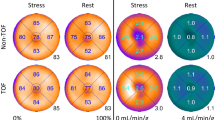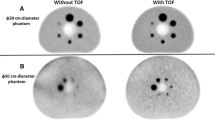Abstract
Purpose of Review
Absolute quantitation of myocardial blood flow has been recognized as one of the most important advances in nuclear cardiology. The addition of absolute myocardial blood flow quantitation has had a significant impact on the determination of normalcy, artifact/defect differentiation, and the true extent of coronary artery disease in patients with known or suspected coronary disease. Time-of-flight reconstruction and point spread function modeling of the potential to greatly improve resolution and signal to background. This combined with absolute blood flow measurements could improve the reliability of regional blood flow estimates and overall image quality.
Recent Findings
Recent publications have demonstrated that time-of-flight reconstruction can have an impact on the amount of spillover between the blood pool ROI and the myocardial regions. This may necessitate changes to kinetic models; however, these changes if implemented correctly may result in improved accuracy and reproducibility of blood flow estimates. This may also have the benefit of assessing blood flow in the microvasculature using newer F-18 labeled blood flow tracers.
Summary
Time of flight and point spread function modeling represent significant improvements in the accuracy and quality of reconstructed myocardial perfusion PET images. This may also have significant implications for the reliability of blood flow estimates. To achieve these benefits, attention must be given to blood flow models to ensure that they have been correctly optimized for the scanner-specific time-of-flight reconstruction properties.





Similar content being viewed by others
References
Papers of particular interest, published recently, have been highlighted as:•• Of major importance
Bateman TM, Dilsizian V, Beanlands RS, DePuey EG, Heller GV, Wolinsky DG. ASNC/SNMMI Position Statement on the Clinical Indications for Myocardial Perfusion PET. J Nucl Cardiol. 2016;23(5):1227–31.
Bateman TM, Dilsizian V, Beanlands RS, De Puey EG, Heller GV, Wolinsky DG. ASNC/SNMMI Position Statement on the Clinical Indications for Myocardial Perfusion PET. J Nucl Med. 2016;57(10):1654–6.
Yoshinaga K, Katoh C, Manabe O, Klein R, Naya M, Sakakibara M, et al. Incremental diagnostic value of regional myocardial blood flow quantification over relative perfusion imaging with generator-produced rubidium-82 PET. Circ J. 2011;75:2628–34.
Ziadi MC, Dekemp RA, Williams K, et al. Does quantification of myocardial flow reserve using rubidium-82 positron emission tomography facilitate detection of multivessel coronary artery disease? J Nucl Cardiol. 2012;19(4):670–80.
Kajander S, Joutsiniemi E, Saraste M, et al. Cardiac positron emission tomography/computed tomography imaging accurately detects anatomically and functionally significant coronary artery disease. Circulation. 2010;122(6):603–13.
Herzog BA, Husmann L, Valenta I, Gaemperli O, Siegrist PT, Tay FM, et al. Long-term prognostic value of 13N-ammonia myocardial perfusion positron emission tomography added value of coronary flow reserve. J Am Coll Cardiol. 2009;54(2):150–6.
Murthy VL, Naya M, Foster CR, Hainer J, Gaber M, di Carli G, et al. Improved cardiac risk assessment with noninvasive measures of coronary flow reserve. Circulation. 2011;124(20):2215–24.
Patel KK, Spertus JA, Chan PS, Sperry BW, Badarin F, Kennedy KF, et al. Myocardial blood flow reserve assessed by positron emission tomography myocardial perfusion imaging identifies patients with a survival benefit from early revascularization. Eur Heart J. 2019;41(6):759–68 0, 1–11.
Wells RG, Marvin B, Poirier M, Renauld J, de Kemp RA, Ruddy TD. Optimization of SPECT measurement of myocardial blood flow with corrections for attenuation, motion, and blood binding compared with PET. Nucl Med. 2017;58(12):2013–9.
Agostoni D, Roule V, Nganoa C, Roth N, Baavour R, Prienti JJ, et al. Manrique, First validation of myocardial flow reserve assessed by dynamic 99mTc-sestamibi CZT-SPECT camera: head to head comparison with 15O-water PET and fractional flow reserve in patients with suspected coronary artery disease, The WATERDAY study. Eur J Nucl Med Mol Imaging. 2018;45(7):1079–90.
Hsu B, Chen FC, Wu TC, Huang WS, Hou PN, Chen CC, et al. Quantitation of myocardial blood flow and myocardial flow reserve with 99mTc-sestamibi dynamic SPECT/CT to enhance detection of coronary artery disease. Eur J Nucl Med Mol Imaging. 2014;41:2294–306.
Sciammarella M, Shrestha UM, Seo Y, Gullberg GT, Botvinick EH. A combined static-dynamic single-dose imaging protocol to compare quantitative dynamic SPECT with static conventional SPECT. J Nucl Cardiol. 2019;26(3):763–7.
Dilsizian V, Chandrashekhar Y, Narula J. Quantitative PET myocardial blood flow: “trust, but verify”. J Am Coll Cardiol Img. 2017;10(5):609–10.
Kitkungvan D, Johnson NP, Roby AE, Patel MB, Kirkeeide R, Gould KL. Routine clinical quantitative rest stress myocardial perfusion for managing coronary artery disease: clinical relevance of test-retest variability. J Am Coll Cardiol Img. 2017;10:565–77.
Heller GV, Beanlands R, Merlino DA, Travin MI, Calnon DA, Dorbala S, et al. ASNC Model Coverage Policy: cardiac positron emission tomographic imaging, J. Nucl Cardiol. 2013;20:916–47.
Murthy VL, et al. Clinical quantification of myocardial blood flow using PET: joint position paper of the SNMMI cardiovascular council and the ASNC, J. Nucl Cardiol. 2017;25:269–97.
Yoshida K, Mullani N, Gould KL. Coronary flow and flow reserve by PET simplified for clinical applications using rubidium-82 or nitrogen-13-ammonia. J Nucl Med. 1996;37:1701–12.
Lortie M, Beanlands RS, Yoshinaga K, Klein R, Dasilva JN, DeKemp RA. Quantification of myocardial blood flow with 82Rb dynamic PET imaging. Eur J Nucl Med Mol Imaging. 2007;34:1765–74.
Choi Y, Huang S-C, Hawkins RA, Kim JY, Kim B-T, Hoh CK, et al. Quantification of myocardial blood flow using 13N-ammonia and PET: comparison of tracer models. J Nucl Med. 1999;40(6):1045–55.
Mullani N, Markham J, Ter-Pogossian M. Feasibility of time-of-flight reconstruction in positron emission tomography. J Nucl Med. 1980;21(11):1095–7.
Conti M. Focus on time-of-flight PET: the benefits of improved time resolution. Eur J Nucl Med Mol Imaging. 2011;38(6):1147–57. https://doi.org/10.1007/s00259-010-1711-y.
Schaefferkoetter J, Ouyang J, Rakvongthai Y, Nappi C, El Fakhri G. Effect of time-of-flight and point spread function modeling on detectability of myocardial defects in PET. Med Phys. 2014;41(6):062502.
Presotto L, Gianolli L, Gilardi MC, Bettinardi V. Evaluation of image reconstruction algorithms encompassing time-of-flight and point spread function modelling for quantitative cardiac PET: phantom studies. J Nucl Cardiol. 2015;22(2):351–63. https://doi.org/10.1007/s12350-014-0023-1.
Dasari PKR, Jones JP, Casey ME, Liang Y, Dilsizian V, Smith MF. The effect of time-of-flight and point spread function modeling on 82 Rb myocardial perfusion imaging of obese patients, Armstrong IS, Understanding the impact of advanced PET reconstruction in cardiac PET: The devil is in the details. J Nucl Cardiol. 2018;25(5):1521–45. https://doi.org/10.1007/s12350-018-1311-yThis article describes the details of how the point spread function modelling and time-of-flight reconstruction change the blood flow model.
Ian S. Armstrong 1, Christine M Tonge, Parthiban Arumugam, Impact of point spread function modeling and time-of-flight on myocardial blood flow and myocardial flow reserve measurements for rubidium-82 cardiac PET. J Nucl Cardiol. 2014;21(3):467–74. https://doi.org/10.1007/s12350-014-9858-8.
Kero T, Nordström J, Harms HJ, Sörensen J, Ahlström H, Lubberink M. Quantitative myocardial blood flow imaging with integrated time-of-flight PET-MR. EJNMMI Phys. 2017;4(1):1. https://doi.org/10.1186/s40658-016-0171-2.
Tomiyama T, Ishihara K, Suda M, Kanaya K, Sakurai M, Takahashi N, et al. Impact of time-of-flight on qualitative and quantitative analyses of myocardial perfusion PET studies using (13)N-ammonia. J Nucl Cardiol: official publication of the American Society of Nuclear Cardiology. 2015;22(5):998–1007.
Ullah MN, Pratiwi E, Cheon J, Choi H, Yeom JY. Instrumentation for time-of-flight positron emission tomography. Nucl Med Mol Imaging. 2016;50(2):112–22. https://doi.org/10.1007/s13139-016-0401-5.
van Sluis J, de Jong J, Schaar J, Noordzij W, van Snick P, Dierckx R, et al. Performance characteristics of the digital biograph vision PET/CT system. J Nucl Med. 2019;60(7):1031–6. https://doi.org/10.2967/jnumed.118.215418 Epub 2019 Jan 10.
Pan T, Einstein SA, Kappadath SC, Grogg KS, Lois Gomez C, Alessio AM, et al. Performance evaluation of the 5-Ring GE Discovery MI PET/CT system using the national electrical manufacturers association NU 2-2012 Standard. Med Phys. 2019;46(7):3025–33. https://doi.org/10.1002/mp.13576.
Germino M, Ropchan J, Mulnix T, et al. Quantification of myocardial blood flow with (82)Rb: validation with (15)O-water using time-of-flight and point-spread-function modeling. EJNMMI Res. 2016;6(1):68. https://doi.org/10.1186/s13550-016-0215-6These findings demonstrate the modifications to the single-tissue compartment kinetic model that are necessary for maintaining the accuracy of blood flow estimates.
Kadrmas DJ, Frey EC, Karimi SS, Tsui BM. Fast implementations of reconstruction-based scatter compensation in fully 3D SPECT image reconstruction. Phys Med Biol. 1998;43(4):857–73.
Borges-Neto S, Pagnanelli RA, Shaw LK, et al. Clinical results of a novel wide beam reconstruction method for shortening scan time of Tc-99m cardiac SPECT perfusion studies. J Nucl Cardiol. 2007;14(4):555–65.
Druz RS, Phillips LM, Chugkowski M, Boutis L, Rutkin B, Katz S. Wide-beam reconstruction half-time SPECT improves diagnostic certainty and preserves normalcy and accuracy: a quantitative perfusion analysis. J Nucl Cardiol. 2011;18(1):52–61.
Venero CV, Heller GV, Bateman TM, McGhie AI, Ahlberg AW, Katten D, et al. A multicenter evaluation of a new post-processing method with depth-dependent collimator resolution applied to full-time and half-time acquisitions without and with simultaneously acquired attenuation correction. J Nucl Cardiol. 2009;16(5):714–25.
Teoh EJ, McGowan DR, Macpherson RE, Bradley KM, Gleeson FV. Phantom and clinical evaluation of the Bayesian penalized likelihood reconstruction algorithm Q.Clear on an LYSO PET/CT System. J Nucl Med. 2015;56(9):1447–52. https://doi.org/10.2967/jnumed.115.159301.
Surti S, Karp JS. Experimental evaluation of a simple lesion detection task with time-of-flight PET. Phys Med Biol. 2009;54:373–84.
Lois C, Jakoby BW, Long MJ, Hubner KF, Barker DW, Casey ME, et al. An assessment of the impact of incorporating time-of-flight information into clinical PET/CT imaging. J Nucl Med. 2010;51:237–45.
Vaquero JJ, Kinahan P. Positron emission tomography: current challenges and opportunities for technological advances in clinical and preclinical imaging systems. Annu Rev Biomed Eng. 2015;17:385–414. https://doi.org/10.1146/annurev-bioeng-071114-040723.
Miwa K, Wagatsuma K, Nemoto R, Masubuchi M, Kamitaka Y, Yamao T, et al. Detection of sub-centimeter lesions using digital TOF-PET/CT system combined with Bayesian penalized likelihood reconstruction algorithm. Ann Nucl Med. 2020;34(10):762–71. https://doi.org/10.1007/s12149-020-01500-8.
Patel KK, Spertus JA, Chan PS, Sperry BW, al Badarin F, Kennedy KF, et al. Myocardial blood flow reserve assessed by positron emission tomography myocardial perfusion imaging identifies patients with a survival benefit from early revascularization. Eur Heart J. 2020;41:759–68.
Author information
Authors and Affiliations
Corresponding author
Ethics declarations
Conflict of Interest
James A. Case reports he is employed by CVIT.
Human and Animal Rights and Informed Consent
This article does not contain any studies with human or animal subjects performed by any of the authors.
Additional information
Publisher’s Note
Springer Nature remains neutral with regard to jurisdictional claims in published maps and institutional affiliations.
This article is part of the Topical Collection on Nuclear Cardiology
Rights and permissions
About this article
Cite this article
Case, J.A. The Importance of Time-of-Flight Reconstruction and Point Spread Modeling in the Measurement of Myocardial Blood Flow Parameters. Curr Cardiol Rep 23, 77 (2021). https://doi.org/10.1007/s11886-021-01507-1
Accepted:
Published:
DOI: https://doi.org/10.1007/s11886-021-01507-1




